Ad copy.
It’s one of the most important aspects of creating a high-performing Google Ads campaign, so making sure you get it right is critical.
First things first, there is a time to be cute and creative with your ad copy, and this is not it.
Google Ads content is bottom of funnel (BoFu) content, meaning you are catching potential customers at the moment they are ready to buy or sign up. It is also important to remember that it is intent-based content; in other words, someone is looking for a solution, and you are there at the right moment to provide that solution.
All of this means you have, quite literally, a fraction of a second to grab the attention of an interested searcher before they skip over your ad and go to the next one—probably the one your competitor created.
That said, let’s start at the beginning.
This blog is based on a video Kasim created to help guide you through the process of writing the best possible Google Ads text ads. You can watch the video here, or keep reading as we walk through the technical aspects of creating your ads, introduce some best practices, and wrap up with some helpful recommendations.
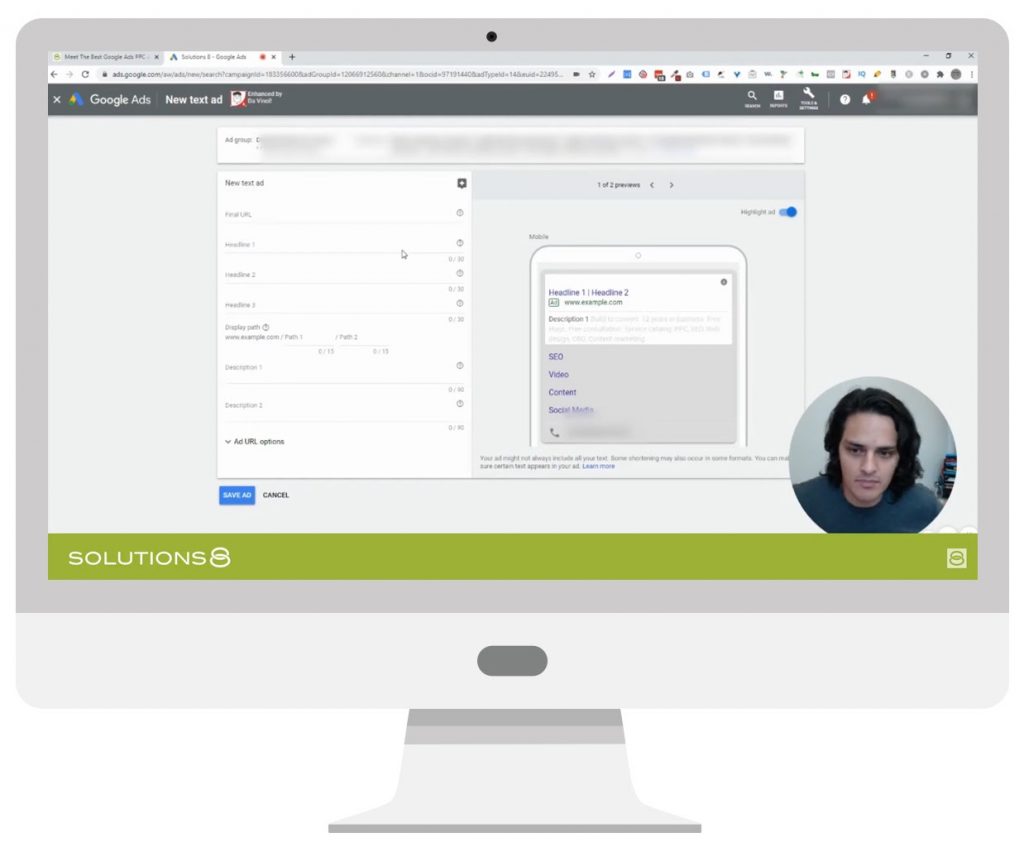
CREATING YOUR AD COPY
Inside your Google Ads account, you can start creating your ad copy by going to Ads and Extensions, selecting Ads, clicking on the + button, and choosing Add a Text Ad.
Right out of the gate, Google will tell you what ad group you are writing this ad for and the keywords associated with that ad group, which is helpful when it comes to composing your copy.
Pro Tip! Your Ad Groups should be broken down in a way that ensures you are not trying to fit too many keywords into one group (aim for about 10 to 15, on average). If your keyword list becomes too expansive, consider breaking them up into smaller Ad Groups.
The first thing you will see is a space for the Final URL.
Your Final URL is where you are actually sending the people who click on your ads, so make sure it is where you want them to go as an end result. For example, if someone searches for “reflective dog collar,” take them right to the page on your site that features that collar and not to your home page, where they would have to search again for the collar within your actual site.
Make sure the Final URL you choose starts with “https://” because some browsers may give you an error if it doesn’t. (Note: People who click on your ad will not see the Final URL.)
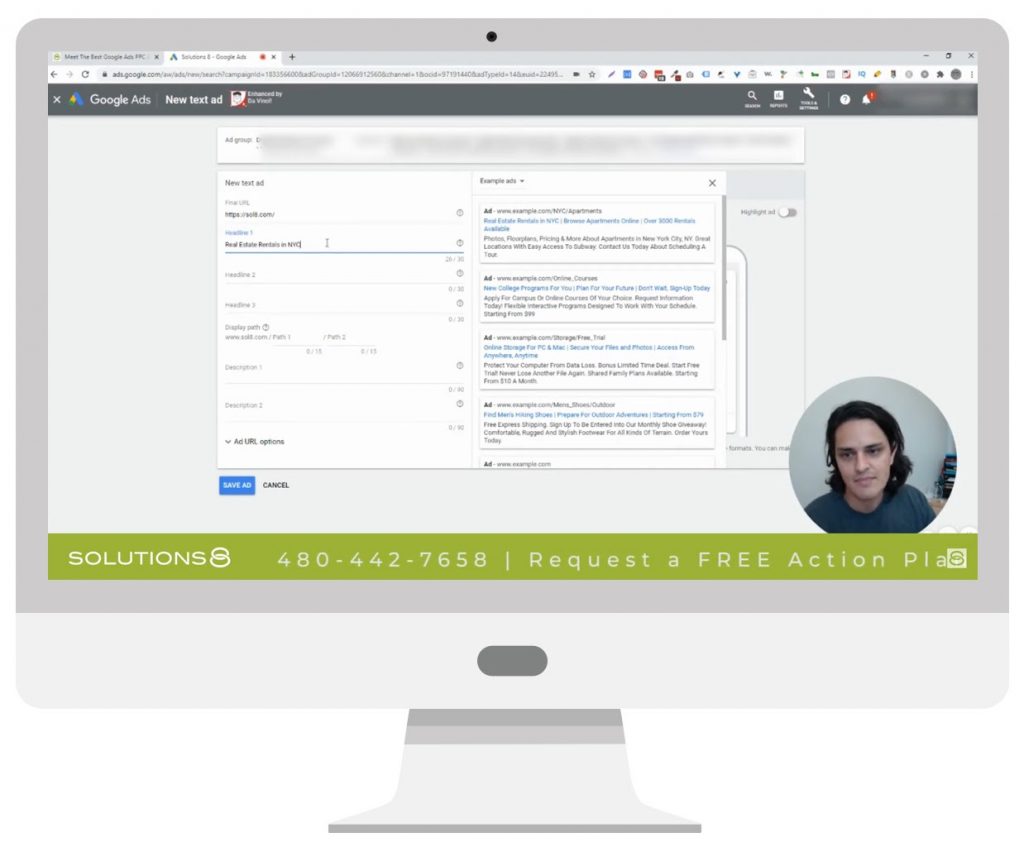
Next up: headlines.
You will see a space for three headlines. Headlines 1 and 2 will always appear, but Headline 3 may or may not show up based on ad relevance and rank.
Your headlines should address both relevancy and pain points at the same time, and you always want to use title case (i.e., the first letter of every word is capitalized) because data shows that it consistently performs better for click-through rate (CTR).
Headline 1 should very closely match the keyword that a user types in. For Headlines 2 and 3, focus on highlighting key features and benefits. Keep in mind that you have a limit of 30 characters, and it is worth trying to occupy as much space as possible with relevant ad copy.
Using numbers and special characters (including dollar signs) will make your ad stand out and will typically increase your click-through rate. Just keep in mind that Google does not like excessive capitalization (e.g., “GET THIS AWESOME THING FREE”) and may penalize you.
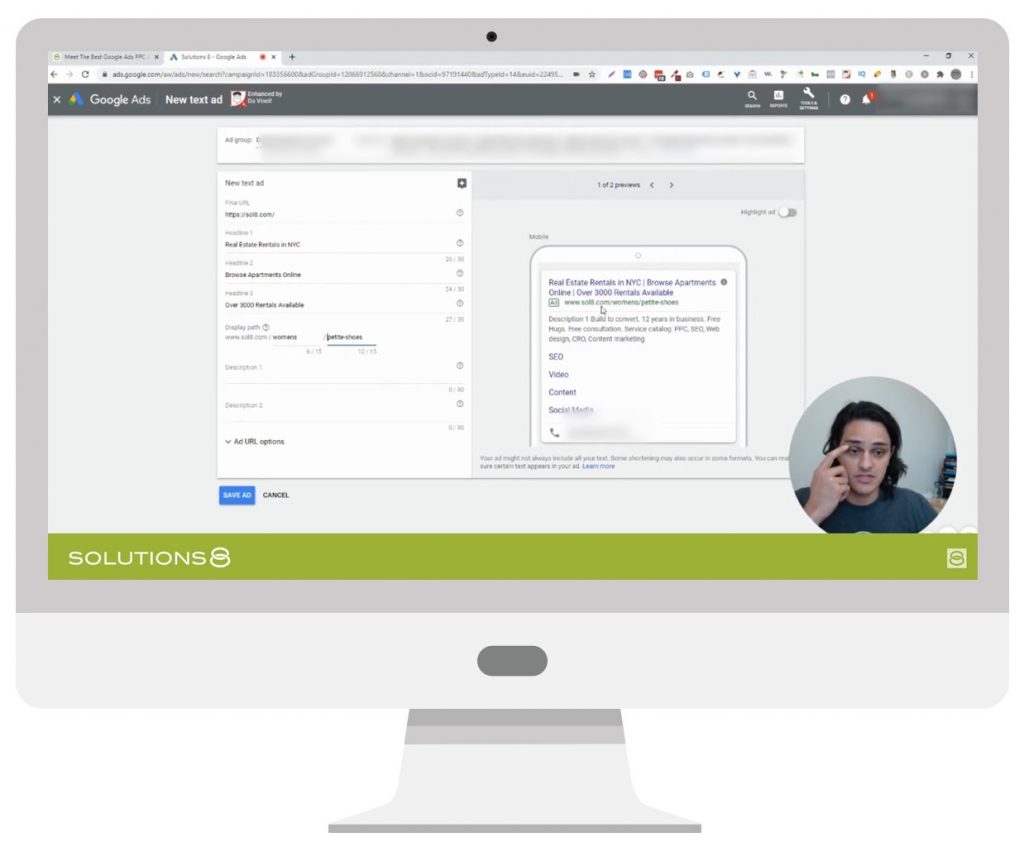
Moving on to Display Path.
The Display Path is the URL that users will see in your ad. Google allows for dashes here, and Kasim recommends using them to help users know that this is exactly what they will find if they go to your website page. (e.g, www.janesshoes.com/womens/petite-shoes).
Pro Tip! Use your Display Path to speak to what it is people are going to get.
The more specificity you provide, the better your ad is going to perform.
The next section you will see is Descriptions.
Kasim points out that although this is where people spend the most of their time, there is, in fact, a hierarchy of importance with ad copy, and if your title (i.e., your combined headlines as they appear at the top of your ad) is not good, people are not going to take the time to read your descriptions.
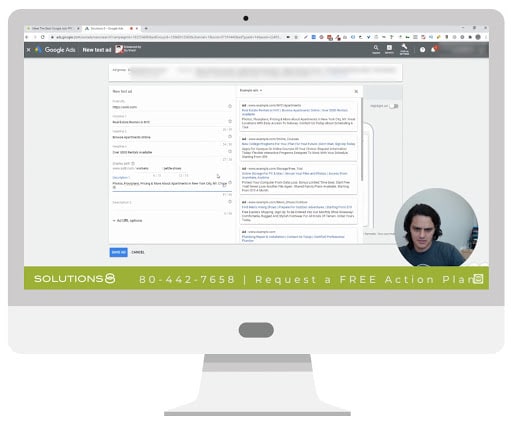
When crafting your descriptions, do your best to use all 90 of your allotted characters, but make them really short snippets that people can skim over to get more information. Think bullet points as sentences. Why? Because people are not going to read a long, wordy paragraph.
At this point in the video, Kasim points out the importance of Extensions and why you always want to use them because Google tends to prioritize campaigns with Extensions. And, because it factors into your quality score, the more extensions you have, the better your ad will perform. More on that here.
Pro Tip! It’s worth downloading Google Ads Editor instead of creating ad copy right in the dashboard because it makes it a lot easier to see what your ad will look like.

TECHNICAL BEST PRACTICES FOR TEXT ADS
At this point in the video, Kasim does a quick recap of the ad elements he has talked about so far to make sure viewers have a good jumping off point for creating amazing text ads in the Google Ads platform. These elements include:
- ✓ Headlines 1 and 2 are critical, but Headline 3 may not always show up.
- ✓ Descriptions should be short and sweet.
- ✓ Be as specific as possible with your Display URL.
- ✓ Always use title case for better CTR.
- ✓ Use numbers and special characters.
- ✓ Understand the ad copy hierarchy.
- ✓ Include your keyword(s), but not too often and not in the title.
Pro Tip! In the space for Headline 1, if you type an open squiggly bracket ( { ),
you will see options for three types of dynamic insertion: Keyword insertion, Countdown, and If function. The Keyword insertion option specifically allows the keyword that triggered this ad to be inserted in your ad copy.
- ✓ Maintain continuity with your landing page. Make sure the description, the offer, and the value proposition is preparing viewers for what they will see on the landing page. Not only does this continuity help build trust, but it’s also really important for your quality score.
- ✓ Always be testing! Google recommends running 2 expanded text ads + 1 responsive ad, and then constantly testing them against one another.
- ✓ Use a clear call to action (CTA). Remember, this is BoFu content, so be as direct as possible.
- Get (35%)
- Buy (20%)
- Shop (18%)
- Try (14%)
- Learn (9%)
- Build (6%)
- Sign up (4%)
- Discover (2%)
- Click (0%)
However, this list is continually changing over time as marketers repeatedly use certain words, causing their efficacy to taper off. Still, it is worth noting what people are responding to right now.
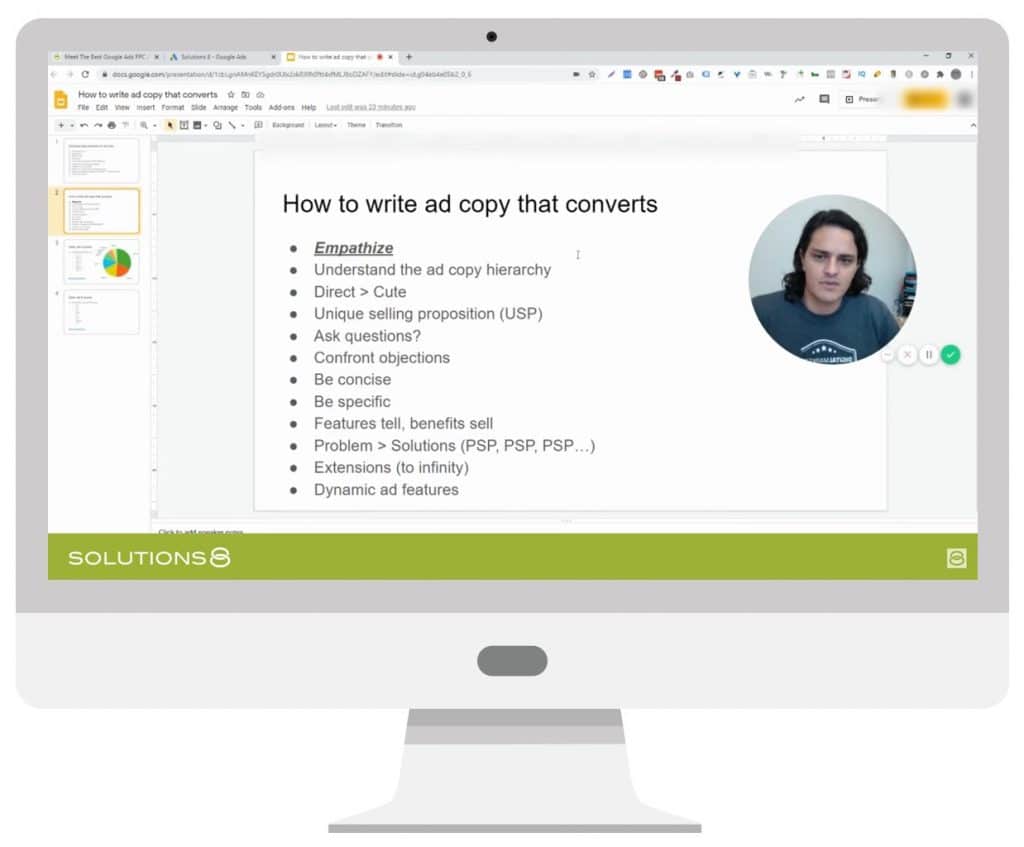
STRATEGY AND TACTICAL TIPS
In this section, Kasim shares some quick tips for writing ad copy that converts:
- Empathize. Empathy is the most important skill to cultivate as a marketer. It’s all about solutions, putting yourself in other people’s shoes and helping them solve a problem. Ask yourself, “What would a solution look like or feel like for my potential customers?” and put yourself in that frame of mind to create better ad copy.
- Understand the ad copy hierarchy.
- Be direct, not cute.
- Know your unique selling proposition (USP). Setting yourself apart in such a competitive ecosystem means knowing what is unique to your business and using that to appeal to your audience.
- Ask questions. Questions in ads capture people’s attention, and subconsciously they begin to answer those questions automatically when they see them in your ad.
- Confront objections. Don’t be afraid to add language that both attracts and repels. In other words, don’t hide things that would prevent a sale. Be up front and honest about whether or not you are the right fit.
- Be concise. Use plenty of snippets, bullets, etc.
- Be specific. If you can’t get specific enough, your Ad Groups are probably too broad.
- Features tell, benefits sell. Speak to the end result and how your product or service will improve the lives of your potential customers.
- Problem, solution, problem (PSP). Maintain the attention of your audience by presenting a problem that resonates with them, providing a solution, and then presenting another problem to start the cycle over. You can easily set this cycle in motion within your Google Ads ad copy.
- Extensions. Use extensions to infinity!
- Utilize dynamic ad features.
Ready to rock your Google Ads? You’ve got this!
Need a little more help?
Check out our complete, step-by-step Google Ads tutorial, or contact Solutions 8 today for a FREE Google Ads action plan built by the industry’s best Google Ads management team. And don’t forget to Like, Subscribe, and tell your friends about the Solutions 8 video library so they can be successful with Google Ads, too.

Author
Patience is the former director of marketing and communications for Solutions 8. A phenomenal content writer, copywriter, editor, and marketer, she has played a prominent role in helping Solutions 8 become an authority in the Google Ads space. Patience is also the co-author of The Ultimate Guide to Choosing the Best Google Ads Agency and You vs Google.
 Patience Hurlburt-Lawton
Patience Hurlburt-Lawton










